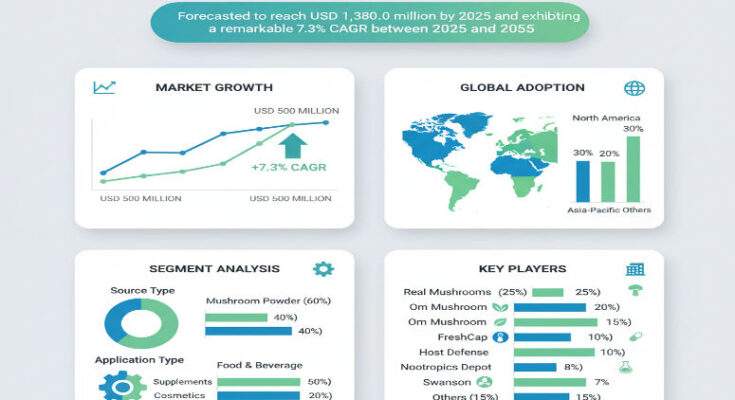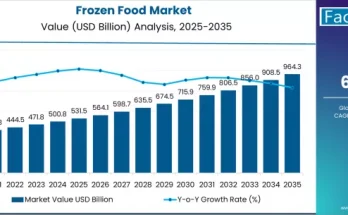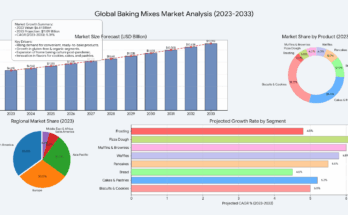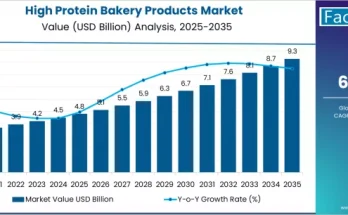The global lion’s mane market is estimated at USD 680.0 million in 2025, and is forecast to reach approximately USD 1,380.0 million by 2035, growing at a compound annual growth rate (CAGR) of 7.3% over the the decade. This trajectory underscores increasing adoption of lion’s mane as a functional and medicinal mushroom with wide appeal in nootropic, cognitive health, and wellness sectors. The growth reflects both rising consumer demand for natural ingredients and increased incorporation of lion’s mane products into supplements, functional foods, and wellness formulations.
Market Drivers & Growth Catalysts
Several factors are driving this expansion. One key driver is growing consumer awareness of cognitive health, memory, focus, and brain wellness, leading to rising demand for natural nootropic ingredients like lion’s mane. Manufacturers of dietary supplements and wellness products are leveraging the mushroom’s reputed benefits in supporting nerve health, cognition, and mental clarity. Another catalyst is the broader trend toward clean-label, plant-based and natural health products, which encourages formulators to include lion’s mane in supplement blends, functional beverages, and wellness foods. Advances in extraction technologies and formulation science are improving the bioavailability and consistency of active compounds, enhancing product efficacy and consumer acceptance.
Product Forms & Application Segments
Lion’s mane products are offered in several forms, including standardized extracts, powders, capsules or tablets, functional food & beverage ingredients, and possibly other formats. Extracts often dominate due to their concentrated bioactive compounds and easier use in supplement and functional food formulations. Powders are preferred in some applications for blendable formats and versatility. In terms of application, dietary supplements and cognitive health products are leading segments, followed by functional foods, beverages, and wellness product lines aimed at cognitive function, mental clarity, stress relief or general wellness positioning.
Regional Insights & Growth Potential
Regions with mature wellness markets, such as North America and Europe, are core markets where regulatory frameworks support dietary supplements and natural wellness ingredients, and where consumers are increasingly health-aware. These regions likely maintain substantial share and early adoption of high-quality, standardized lion’s mane extracts. Meanwhile, Asia-Pacific is emerging as a high growth region: rising middle classes, growing functional food and supplement industries, and increasing awareness of natural health and traditional herbal practices are fueling demand for lion’s mane products. Other emerging regions (Latin America, Middle East & Africa) also show potential as wellness product penetration increases and local manufacturers or distributors expand.
Competitive Landscape & Strategic Trends
The competitive landscape includes extract manufacturers, supplement producers, functional food & beverage brands, and ingredient suppliers. Key players in this space focus on standardizing extract formulations, ensuring quality and consistency of bioactive compounds, optimizing extraction processes, and developing certifications (organic, sustainable cultivation, validated active compounds). Partnerships between ingredient suppliers and supplement/functional food brands are common to integrate lion’s mane into product lines. Market participants are also investing in R&D to improve stability, bioavailability, and consistent supply of lion’s mane-derived ingredients.
Challenges & Market Restraints
There are some constraints. Variability in raw material supply (cultivation, climate, seasonal yield) may impact consistency of bioactive constituents. Extraction and standardization requirements add complexity and cost for producers. Regulatory compliance varies across regions, especially for claims around cognitive or medicinal benefits, which can slow product approvals or market entry. Price sensitivity in certain markets may limit adoption of premium, standardized extract products versus lower quality or cheaper alternatives.
Forecast & Strategic Recommendations
With the market expected to grow from USD 680.0 million in 2025 to USD 1,380.0 million by 2035 at a 7.3% CAGR, the outlook is strong for companies operating in this category. Ingredient suppliers should invest in expanding cultivation capacity, improving extract standardization, and ensuring high and consistent active compound content. Collaborating with supplement brands and functional food manufacturers will help drive product innovation and integration. Expanding presence in fast-growing regions (primarily Asia-Pacific) and adapting product formulations to local consumer preferences will also support growth.
Browse Full Report: https://www.factmr.com/report/1117/lions-mane-market
Editorial Perspective
Lion’s mane has moved beyond niche functional mushroom status into a mainstream wellness ingredient with strong appeal in nootropic and cognitive supplement categories. As consumers place greater emphasis on mental clarity, cognitive performance, and natural wellness solutions, standardized lion’s mane products will continue gaining traction. Suppliers and brands that deliver high quality, consistent extracts and innovative formulations will be well positioned to capture a large share of the projected USD 1,380 million market by 2035.



